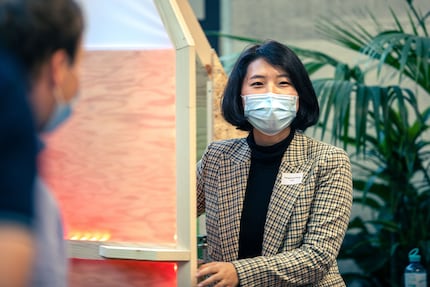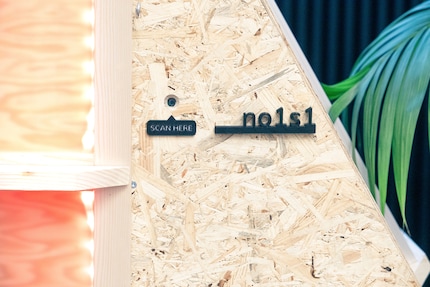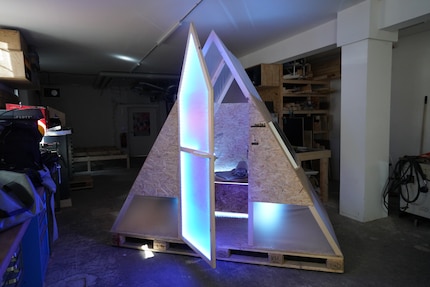

From a quick browse to a blockchain house: here’s how we equipped no1s1
Big ideas sometimes reveal themselves in the smallest of spaces – or in this case, a four square-metre meditation booth. In fact, the cottage is supposedly even slated to become the first building in the world that is self-owned and soon-to-be self-managing. All powered by gadgets from our store.
Two simple wooden pallets support the small, triangular cabin. Its walls are made of chipboard and thin plastic sheets. Soft lights escape hazily from inside – it’s meant to be cosy, as this room is intended for meditation.
However, finding inner peace is only of secondary importance here. The project, which was recently presented at ETH Zurich, has greater aspirations: it’ll be the world’s first self-owned and self-managing building.
But how is something like this even possible?
Powered by the blockchain
Our word of the day is blockchain technology. Or words. According to what the mastermind behind the no1s1 («No one’s one») prototype, Hongyang Wang, is trying to explain to me right now, that is. She completed the cabin with funding from the consulting firm Ernst & Young and in collaboration with the think tank Dezentrum.
To finish her project, Hongyang spent many weeks in the think tank’s cool basement studio in Zurich’s Kreis 2, which focuses on digitisation and society. And now here she is, standing in the large Student Project House at ETH Zurich, pointing at a monitor next to her wooden construction: «The meditation cabin no1s1 has an address on the blockchain,» she says.

For those who’ve already exchanged one or the other crypto coin, this statement is probably understandable. I had to refresh my knowledge on this a bit first: the blockchain is a database on the Internet that you can think of as a chain of virtual blocks.
The blocks are distributed over many computers, but always carry the exact same encrypted information. In order for a command or transaction to be triggered, the information on all blocks must match – which is precisely where its benefit lies: thanks to this digital infrastructure, you can’t manipulate or cheat the blockchain.
Participants in this virtual, trusted network are represented – as Hongyang says – as addresses on the blockchain. These can be people, objects or even artificial intelligence – the blockchain makes no distinction in this respect.
Take the Bitcoin blockchain, for example: an address there is only to be understood as a virtual destination or origin of Bitcoin transactions. Bitcoin was the first blockchain of its kind, and is currently probably the best known. However, other blockchains are now available. «For this project, we chose the Ethereum blockchain,» Hongyang continues. Crucially, the Ethereum blockchain offers an important opportunity: it can carry so-called smart contracts. These are central to the project.
No meddling humans
Smart contracts are computer protocols that initiate transactions when predetermined conditions are met. Sounds complicated, but you can simplify it like this: if you put three francs into a vending machine, you get a Coke – inserting three francs was pre-programmed as a condition for getting a Coke.
But this functional logic can be extended far beyond beverage vending machines, and can even be applied to organisations – groups of individuals pursuing a singular goal. The organisation is then represented by rules encoded in a transparent computer program. These organisations are known as Decentralised Autonomous Organisations, or DAOs for short. Hierarchically flat networks on the blockchain, in other words, which function according to the laws of a smart contract and are managed by all members.
But yet again, this is nothing new for Bitcoin enthusiasts or crypto-nerds. Here’s the innovative part: Hongyang and her project team want to take the concept of DAO and connect it to a physical location that belongs only to itself, a first according to the company.
And that’s exactly why it’s so special: currently, there are projects that connect DAOs to physical spaces – however, these items aren’t autonomous places such as a meditation booth. They’ve termed this Decentralised Autonomous Space (DAS) – instead of Organisation. «I don’t know of any other example where this is being studied in this way,» emphasises the native Chinese researcher.
How our fingers come into play
In order for a connection between the cyber world and this physical meditation cabin to be established at all, connection media in the form of electronic devices are needed. And it just so happens that they come from our store in this case. In fact, we sponsored Hongyang’s prototypes with our equipment.
For the cabin’s backend, a Raspberry Pi Model 4 B was used. This minicomputer controls access to the cabin, atmosphere of the room, the power supply and all security.

To do this, it communicates with a camera, motion sensors, solar panels and the battery, as well as with the automatic locks, ventilation and lights attached to the cabin. These parts were also provided by us.
All of these devices will eventually allow the autonomous organisation behind the meditation booth to manage its finances, user information, and the condition of the booth without human assistance.
How to book a session
Even though the DAO behind the meditation booth isn’t yet fully implemented, you can still book a meditation session already. To use the service, all you need is something called an Ethereum wallet. It’s a virtual wallet that you can fill with, among other things, the cryptocurrency Ether (ETH – not to be confused with the university ETH). Using the wallet, you can book an appointment in the booth via its project page and pay with Ether.
As soon as you’ve transferred the fee, you’ll receive a QR code by mail. Using your smartphone, hold this code against the sensor on the outside wall – and open sesame.

If you finish your meditation session a little earlier than planned, you’ll even get your money back. The cabin registers exactly how long you’re in it – and compensates for the unused time with a corresponding refund.
Until Hongyang and her team have finished implementing the DAO, transactions will only flow between the user and the booth for the time being. «At the moment, no1s1 is simply enriching itself through its profits,» she explains. But their goal, she says, is for the cabin to be making its own expenditures in the future – if repairs are needed, for example. This should be possible once the autonomous organisation is completely in charge of the booth.
«Do we even need to own things?»
It’s no coincidence that this meditation cabin currently only offers the most minimal functionality. After all, no1s1 is a so-called Minimum Viable Product or MVP.
In the startup scene, this refers to the simplest version of a product that a company wants to bring to market. With the help of a slim basic version, an initial exploratory search is to be carried out in hopes of attracting potential customers.
This role will also be taken on by no1s1 – but without a focus on profits. This project focuses solely on society and its future organisation: if the meditation booth MVP proves functional, entire buildings, parks, playgrounds, apartments, concert halls, or even rivers or mountains could own and manage themselves in the future.
Thus, these places could exist without having to guarantee profits to owners or administrators – that is, as long as the place can sustain itself financially, rents need not be increased.
But if you run this thought experiment, important questions arise quickly. «Do we even need to own things?» Hongyang asked me when she first showed me the skeleton of the naked prototype.
Even after a few months, she still hasn’t found a definitive answer. But that wasn’t the goal of this whole exercise either. «No1s1 is meant to open up new social possibilities – or at least initiate a discussion about them,» she says.

Hongyang will continue participating in this discussion in the future. After a leave of absence, she’ll dive deeper into the topic of digital governance as a doctoral student at the Institute of Construction and Infrastructure Management at ETH Zurich, researching possible forms of organisation in the age of digitalisation.
Visit the cabin
If reading this article has made you curious too and you want to see the world’s first self-sufficient cottage with your own eyes, you can: it’s currently located in ETH Zurich’s Student Project House in the middle of the city’s university district.
You can find the related conference paper via this link. There you’ll also find a short, clear video presentation by the lead study author, Jens Hunhevicz.
Or maybe this story has inspired you to come up with a brilliant idea of your own, which you can implement with a Raspi and a few sensors. Feel free to share them with us – maybe a few of our gadgets will come headed your way, too. Until the current semiconductor crisis is over, you’ll have some time to think about it anyway.
«I want it all! The terrifying lows, the dizzying highs, the creamy middles!» – these words spoken by an iconic American TV celebrity could have been mine. It's a take on life I also apply to my job. What does this mean in concrete terms? That every story has its charm; no matter how small, large, exciting or trivial. The more eclectic the mix, the better.
Interesting facts about products, behind-the-scenes looks at manufacturers and deep-dives on interesting people.
Show all

